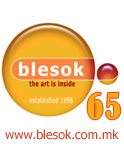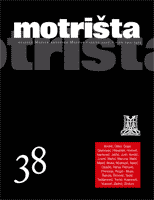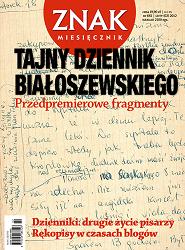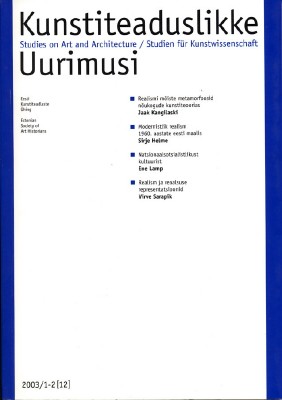
We kindly inform you that, as long as the subject affiliation of our 300.000+ articles is in progress, you might get unsufficient or no results on your third level or second level search. In this case, please broaden your search criteria.











This article will look at changes in post-Second-World-war Estonian painting and graphic art, effected by the introduction of the socialist realist canon. Predominantly, it poses questions about representational transformations designed to construct the new identity of the Soviet Estonian woman, using the examples of the images of working women and of the ethnographic image of the nation-as-a-woman. The discussion of those images will concentrate on how different representations of femininity were utilised for the purposes of official visual propaganda, first of all. At the same time, one has to pay attention to how certain images of women continued to perpetuate – although to a lesser extent – old gender ideologies which in Estonian context could be also read as pro-national and anti-Soviet.
More...
This article aims to describe the phenomenon of the sharing and dispersal of authorship in the new media as essentially belonging to the creative field. The development of authorship has cultural, historical and economic impetus, which has shaped the institution of authorship for hundreds of years. The revolt against authorship, originality, everything made with the author’s own hands, is one of the features of 20th century art, perfectly realised in today’s environment of the Internet and interactive art.
More...
This article aims to describe the phenomenon of the sharing and dispersal of authorship in the new media as essentially belonging to the creative field. The development of authorship has cultural, historical and economic impetus, which has shaped the institution of authorship for hundreds of years. The revolt against authorship, originality, everything made with the author’s own hands, is one of the features of 20th century art, perfectly realised in today’s environment of the Internet and interactive art.
More...
This article will look at changes in post-Second-World-war Estonian painting and graphic art, effected by the introduction of the socialist realist canon. Predominantly, it poses questions about representational transformations designed to construct the new identity of the Soviet Estonian woman, using the examples of the images of working women and of the ethnographic image of the nation-as-a-woman. The discussion of those images will concentrate on how different representations of femininity were utilised for the purposes of official visual propaganda, first of all. At the same time, one has to pay attention to how certain images of women continued to perpetuate – although to a lesser extent – old gender ideologies which in Estonian context could be also read as pro-national and anti-Soviet.
More...
In fine arts the guided investigation – research, as training method extends from the work and creation process to the evaluation of the strategy that led to certain results observable or measurable within an axiological framework and to the assessment of the teaching – learning situation.
More...
The present article offers a summarized vision on the situation of the Bessarabian nude in easel graphic, trying to unveil the local specifics of the evolution of the genre. The study reveals the artistic and stylistic particularities present in the nudes signed by notorious artists like Auguste Baillayre, Alexandru Plamadeala, Moissey Kogan, Eugenia Malashevski and others. The mixture of the works mentioned in this study tries to outline the image of the Bessarabian figurative art, marked by oriental and Western cultural interferences.
More...
Geographical factors, the landscape are key factors in establishing the spatial images. There are differences between the spatial organizations of southern Europe, where assemblies and volumes have been developed horizontally, and Northern Europe, where forms have been developed vertically. The intermediate zone has made a balance between these two trends. At the global level, there are differences on the East - West direction: in the East were developed symmetrical and monumental ensembles and volumes, while the West has developed free and asymmetric compositions, Far East balancing the two tendencies. At the cultural level, the differences in the organization of space are difficult to see. There are models of investigation of Frobenius, Spengler and Lucian Blaga. These theories provide a useful analysis for each culture, rather from inside than outside. This study proposes, in addition, an analysis from the interference of cultures.
More...
On the territory of the two Roman provinces situated in the north of Danube, Dacia Trajan and Scythia Minor, after the Roman conquest, there will be changes both regarding the encountered topics and the artistic style of basreliefs. Once Antiquity ends, PaleoChristianity will add a religious component, with transformations regarding iconography, but also stylistic ones, this field represents one of the proofs of pervasion and spread of the new religion also in these border provinces of the Roman Empire. And this happens at the level of the two types of relief which exist even nowadays, as they did since Antiquity: funeral relief which ornaments monuments and also architectural relief which decorates the new types of buildings, the PaleoChristian basilicas.
More...
The syncretic character of arts gained momentum especially in the second half of the XXth century though the diversification and the transmutation that started from the first decades of the regarded century. The plastic corespondances between graphics, painting, architecture and scenography originate from the relation between the perception of volume and becoming of some shape concept’s space, from sketch up to props and setting. One can represent volume in plastic arts in a large and diverse variety of possibilities, all the more so in which sculpture is regarded. The elements of language, such as the dot, the line, the spot and the shape, complete their expressivity through the plastic language’s value, plastic rithm, chromatic expresivenes through dominance, contrast and harmony. Through that which signifies or symbolize a representation in a specific context of the composition.According to the sculpting creators and therorists the sculpture disposes of a richen potential of expression than the painting or the graphics. This may be because the sculpture has a certain force generated by a tridimensional configuration while it’s volume regenerates. The plastic image that is embrassed on in ronde-bosse, attaches and convoys the content of ideas and the piece of art’s aesthetic value in scenography, more evidently , through its style (functional or spiritual, according to the century’s overview). By amplifying the vibes and the atmosphere of the century’s through architecture (where the volume, the surface and the design coordinate with the science and the art) and through the style of the costumes (outliving time and space) one can create the perfect circumstances for the action this is suggested to the characters whichever these may be eithen in the theatre, cinematography on television.
More...
In every Estonian town one can find single-family houses from the Soviet era, which on the whole were built according to a standardised design and are generally considered a drab expression of a bourgeois lifestyle. These houses, while certainly being an expression of everyday life, might actually be, in the words of Henri Lefebvre, an example of “the concept of everydayness which reveals the extraordinary in the ordinary”. Since opportunities for self-realisation were severely limited, the home as a private and personal sphere became the main avenue for self-expression. In the individual house, the private and the communicating public facade, and the everyday and the festive, became interwoven. Cultural variations and differences in lifestyle, including the hidden hierarchies in the new society which officially proclaimed equality, became beautifully apparent in the individual house.
More...